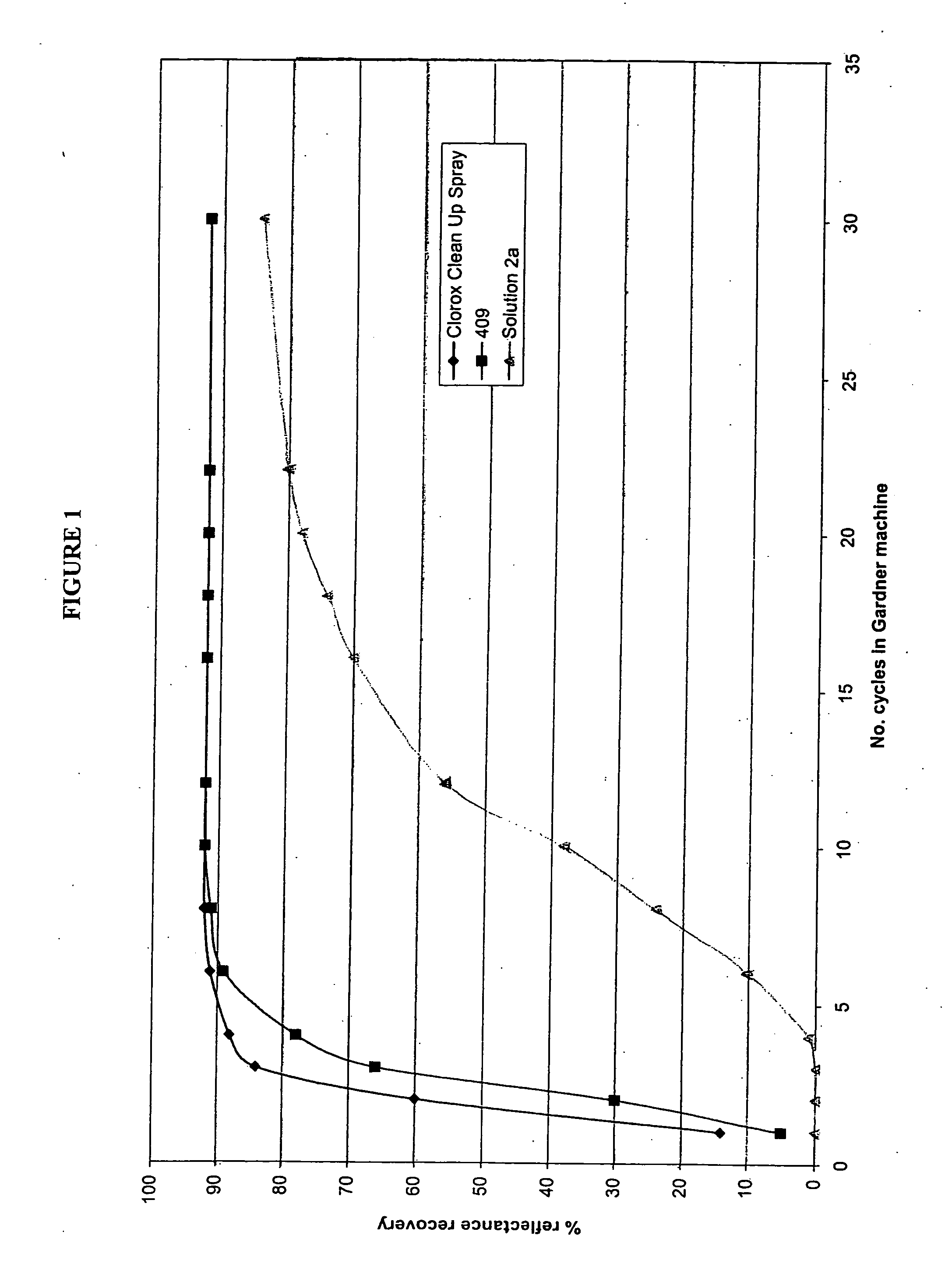Enhanced activity hydrogen peroxide disinfectant
a hydrogen peroxide and disinfectant technology, applied in the field of disinfectants, can solve the problems of inability to meet the needs of the public, and inability to achieve the effect of enhancing the germicidal effect of the solution, and not giving rise to excessive drying and irritation
- Summary
- Abstract
- Description
- Claims
- Application Information
AI Technical Summary
Benefits of technology
Problems solved by technology
Method used
Image
Examples
example 1
[0079] Hard surface disinfectant solutions 1a and 1b were prepared as shown in Table 1a below:
TABLE 1aSolution (w / w %)INGREDIENT1a1bBiosoft S-1000.150.15BRIQUEST ADPA-60AW0.470H2020.600.60deionized waterbalance to 100balance to 100pH1.81.8
[0080] Solutions 1a and 1b were tested as specified in American Society of Testing and Materials (“ASTM”) standard quantitative carrier test (ASTM Method E2111-00), described in the publication entitled “Standard Quantitative Test Method to Evaluate the Bactericidal, Fungicidal, Mycobactericidal and Sporicidal Potencies of Liquid Chemical Germicides”,American Society for Testing of Materials, West Conshohocken, Pa.
[0081] The results are shown in Table 1b below:
TABLE 1bSAMPLEControl CFUTest CFULog ReductionSolution 1a6.76 × 10606.76Solution 1b6.76 × 10606.76
[0082] The above results demonstrate that Solutions 1a and 1b are effective in achieving a greater than 6 log reduction in bacterial counts after a three minute contact time.
example 2
[0083] Hard surface disinfectant solutions 2a, 2b and 2c were prepared as shown in Table 2 below.
TABLE 2Solution (w / w %)INGREDIENT2a2b2cCitric Acid0.5001.5000.500Acetic Acid1.7860.1790.179H2O21.0001.0001.000Biosoft S-1000.4500.4500.100Dowfax Hydrotrope0.3000.3000.300Triton X-4050.0440.0440.044Surfonic L-610-30.1500.1500.150pH2.22.22.2
[0084] Solutions 2a, 2b, and 2c were tested using the Gardner scrub test to determine the cleaning efficiency of such solutions as compared to commercially available cleaners, namely Clorox Clean Up™ and 409™. The test procedure is described in the American Society of Testing and Materials (“ASTM”) D 4488-85 (Standard guide for testing cleaning performance of products intended for use on resilient flooring and washable walls) but using simulated test soils better representing each application. Solution 2a was tested on kitchen grease, Solution 2b was tested on bathroom soil, and Solution 2c was tested on tea stains. Each of the specified soils was app...
example 3
[0086] Hard surface disinfectant solutions 3a and 3b were prepared as indicated in Table 3a below and tested in accordance with the Official Methods of Analysis of the Association of Official Analytical Chemists (A.O.A.C.) 16th Edition, 1995 Section 6.3.04, also referred to as the A.O.A.C. Official Method 961.02 titled “Germicidal Spray Products as Disinfectants”, Final Action 1964. This method tests the effectiveness of sprays and pressurized spray products as spot disinfectants for contaminated surfaces. The tests used a contact time of 3 minutes against a 5 w / w % soil load of Staphylococcus aureus (ATCC No. 6538) and 60 slides. The results are shown in Table 3b below. As shown, none of the 60 slides in each experiment tested positive for the specified organism after being exposed to the test solution.
TABLE 3aSolution (w / w %)INGREDIENT3a3bH2020.51.5Biosoft S-1000.450.29Acetic acid0.31Citric Acid0.50.5Dowfax hydrotrope0.1350.135Triton X-4050.04430.0443Surfonic L610-30.150.15deion...
PUM
| Property | Measurement | Unit |
|---|---|---|
| contact time | aaaaa | aaaaa |
| contact time | aaaaa | aaaaa |
| contact time | aaaaa | aaaaa |
Abstract
Description
Claims
Application Information
 Login to View More
Login to View More - R&D
- Intellectual Property
- Life Sciences
- Materials
- Tech Scout
- Unparalleled Data Quality
- Higher Quality Content
- 60% Fewer Hallucinations
Browse by: Latest US Patents, China's latest patents, Technical Efficacy Thesaurus, Application Domain, Technology Topic, Popular Technical Reports.
© 2025 PatSnap. All rights reserved.Legal|Privacy policy|Modern Slavery Act Transparency Statement|Sitemap|About US| Contact US: help@patsnap.com



